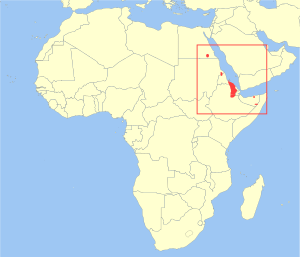Ase salvatge africà
(S'ha redirigit des de: Equus africanus)
L'ase salvatge africà (Equus africanus) és una espècie salvatge de la família dels cavalls, els èquids.[2] Es creu que aquesta espècie és l'avantpassat de l'ase domèstic (Equus asinus), que de vegades es col·loca dins de la mateixa espècie.[3] Viuen als deserts i altres zones àrides de la Banya d'Àfrica, a Eritrea, Etiòpia i Somàlia. Antigament tenia una distribució més àmplia al nord i a l'oest al Sudan, Egipte i Líbia. Es troba en perill crític, amb uns 570 individus existents a la natura.
| Equus africanus | |
|---|---|
 | |
| Dades | |
| Període de gestació | 1 any |
| Període | |
| Estat de conservació | |
 | |
| En perill crític | |
| UICN | 7949 |
| Taxonomia | |
| Classe | Mammalia |
| Ordre | Perissodactyla |
| Família | Equidae |
| Tribu | Equini |
| Gènere | Equus |
| Espècie | Equus africanus (Heuglin i Fitzinger, 1866) |
| Nomenclatura | |
| Protònim | Asinus africanus |
| Subespècies | |
| |
| Distribució | |
Referències
modifica- ↑ Entrada «Equus africanus» de la Paleobiology Database (en anglès). [Consulta: 20 desembre 2022].
- ↑ Wilson, Don E.; Reeder, DeeAnn M. Mammal Species of the World: A Taxonomic and Geographic Reference (en anglès). JHU Press, 2005. ISBN 978-0-8018-8221-0.
- ↑ Staff. «African wild ass is the mother of donkeys, DNA shows». National Geographic Blogspot. National Geographic, 10-08-2010. Arxivat de l'original el 17 August 2010. [Consulta: 8 novembre 2010].
